Teacher's guide
Table of Contents
- Objective
- Engaging Youth
- Planning an All About Cannabis Lesson
- Additional Resources
- All About Cannabis Lesson Guide
- Teacher’s Notes Legend
- Post-Module Survey
Objective
The goal of this presentation is to provide teachers with resources to help their grade 9 to 12 students understand the risks of cannabis use. The program includes:
- What cannabis is;
- Short- and long-term effects of cannabis use on mental health and brain function;
- Information on addiction and stigma;
- Healthy habits to cope with mental health challenges.
It also includes some interactive activities to keep students engaged.
This page aims to provide you with tips and tools to host your own All About Cannabis lesson.
Engaging youth
This program provides you with everything you need to build your own All About Cannabis lesson, including a slideshow, speaking notes, and additional resources. The materials have been created to help you deliver fact-based information, thought-provoking activities, and tools to help your students make healthy choices.
Here are some tips to help you engage with your students in a way that promotes open and positive communication:
- Active listening: Ask open-ended questions, encourage discussion and let them know you hear them.
- Get in the right frame of mind: Understand their perspective.
- Respond clearly: Answer their questions.
- Be straightforward: Let them know your intent.
- Be calm: Offer a relaxed, judgement-free zone.
To learn about more strategies for talking to youth about substances, see Talking with teenagers about drugs and alcohol and Talking with your kids about cannabis.
Planning an All About Cannabis lesson
Estimated duration: Approximately 60–90 minutes
| Introduction | (2-5 mins) |
| Cannabis in Canada | (10-15 mins) |
| Types of Cannabis | (10-15 mins) |
| Effects of Cannabis | (10-15 mins) |
| Addiction and Stigma | (5-10 mins) |
| Healthy Habits | (5-10 mins) |
| Trivia | (10-15 mins) |
| Additional Resources and Q&A | (5-10 mins) |
Things to consider
- Location: This program can easily be done from your regular classroom. For home learning, students should find an area in their home where they are comfortable.
- Technical requirements: You will need internet access and a projector or large monitor to share the module content for the class.
- Students with access to individual computer, tablet or mobile devices will be able to engage with the interactive content on their own screens.
Additional resources
Are your students interested in continuing the conversation on cannabis? Please share these resources with your students and their parents or guardians for more information:
- Presentation Summary of All About Cannabis
- General information on substances
- Talking with teenagers about drugs and alcohol
- Is cannabis safe to use? Facts for youth aged 13–17 years
- Kids Help Phone
- Cannabis and mental health – Canada.ca
- Video: Hannah shares her story about cannabis use
- Video: A medical professional talks about the risks associated with cannabis use
All About Cannabis lesson guide
Before getting started, please ensure you have the following:
- The All About Cannabis slides are set up and visible to the students.
- Students have access to a computer or tablet for interactive activities.
Post-module survey
Thank you for participating in Health Canada’s All About Cannabis teacher-led module. We hope you found the content and its delivery informative for your students.
We would love your feedback on the module! Please take a few minutes to fill out the Teacher Feedback Survey.
Health Canada also offers other programs on substance use, including:
Find out more at HealthCanadaExperiences.ca.
Teacher's notes legend
| Directions are in green. |
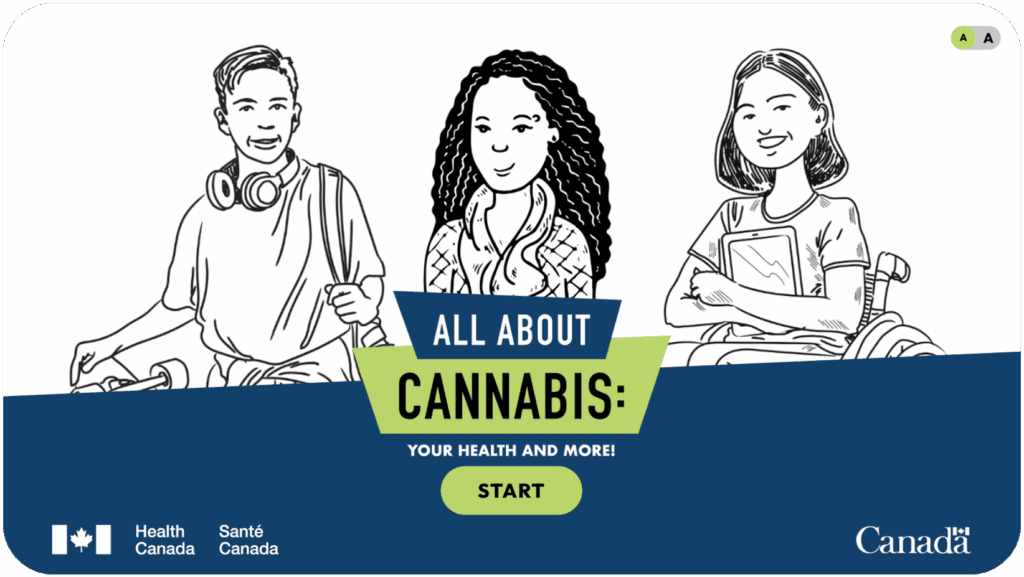
Teacher's Notes
Good [morning/ afternoon], class. Today we are going to have a special presentation.
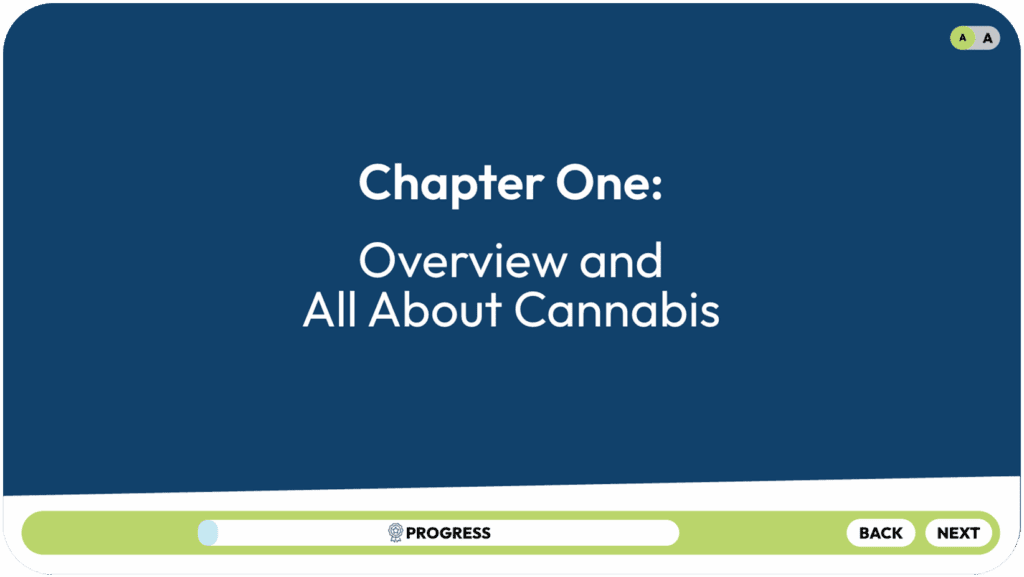
Teacher's Notes
Chapter 1: Overview and All About Cannabis
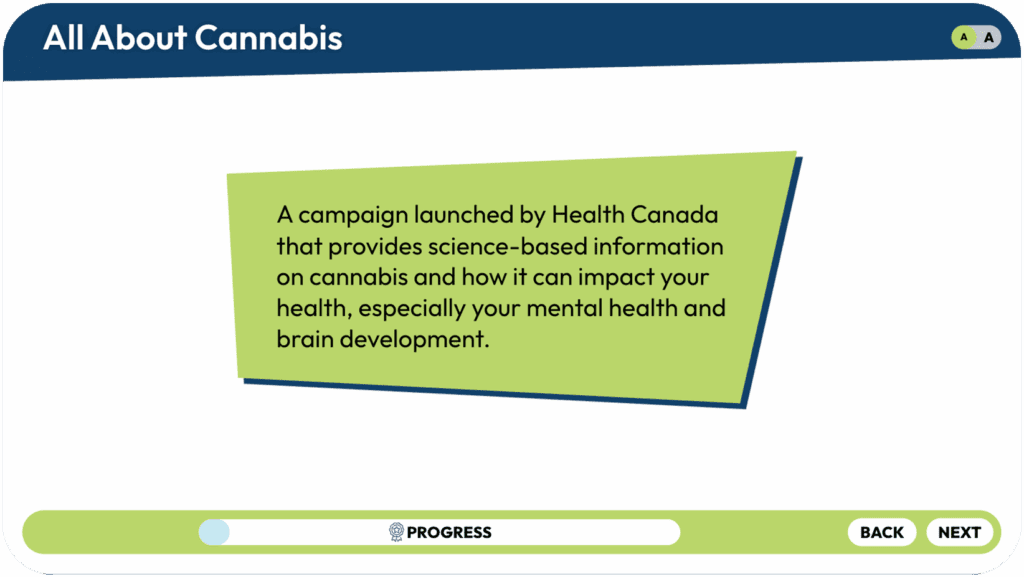
Teacher's Notes
All About Cannabis is a program developed by the Government of Canada to provide science-based information on cannabis, to help you better understand its impact on your health, particularly related to your mental health and brain development.
Feel free to ask questions as we go.

Teacher's Notes
What we’re covering today:
- What is cannabis, its different properties and uses
- Immediate effects and long-term risks of cannabis
- Addiction and stigma surrounding cannabis use
- Ways to protect your mental health
- A Q&A session and resources for more information
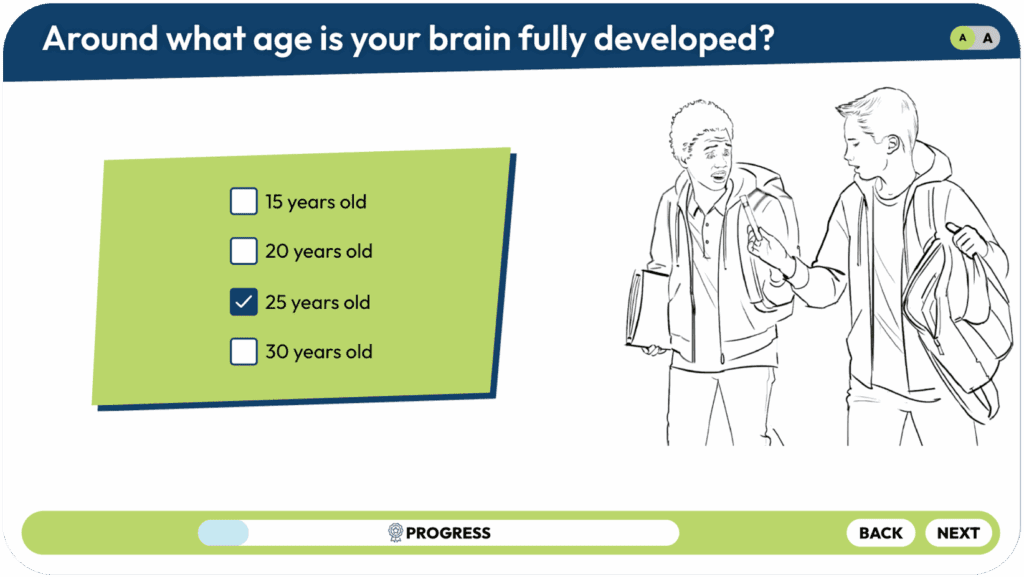
Teacher's Notes
Let’s start with a pop quiz to gauge your knowledge:
Around what age is your brain fully developed? Raise your hand for 15 years old, 20 years old, 25 years old, or 30 years old?
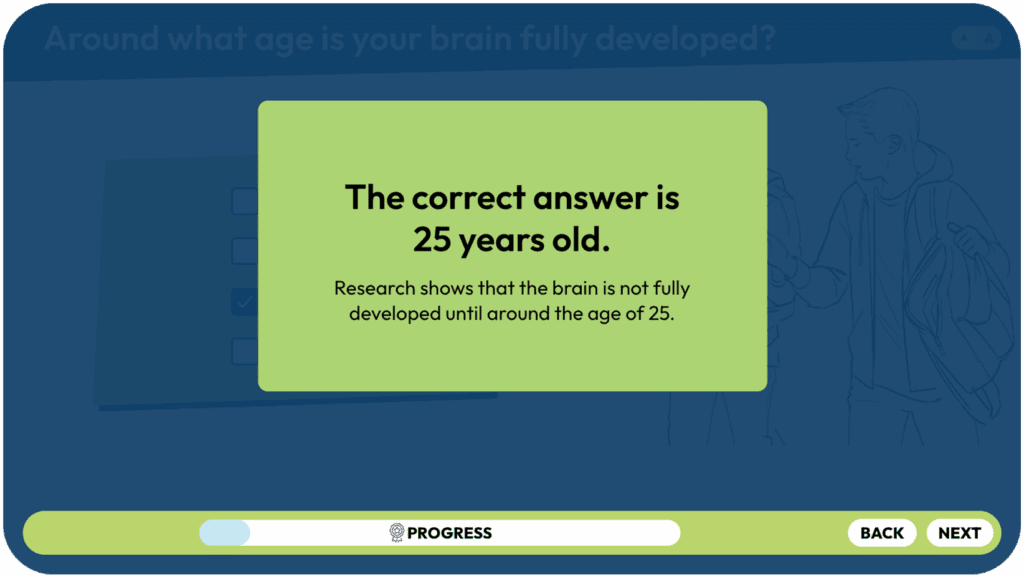
Teacher's Notes
After the class votes:
The correct answer is 25 years old. Research shows that the brain is not fully developed until around the age of 25, including areas of the brain responsible for your emotions, memory, and thinking ability. Since the brain continues to grow until the age of 25, using cannabis before this age can harm the way your brain develops and works.
This is why youth and young adults are especially vulnerable to the effects of cannabis. The earlier you start using the more harm it can do.
However, just because you may have used it once or use it every once in a while, it doesn’t mean that cannabis will be harmful. As you’ll hear today, the level of risk can depend on how often you use cannabis and the way you use it.

Teacher's Notes
So, let’s talk about cannabis in Canada.
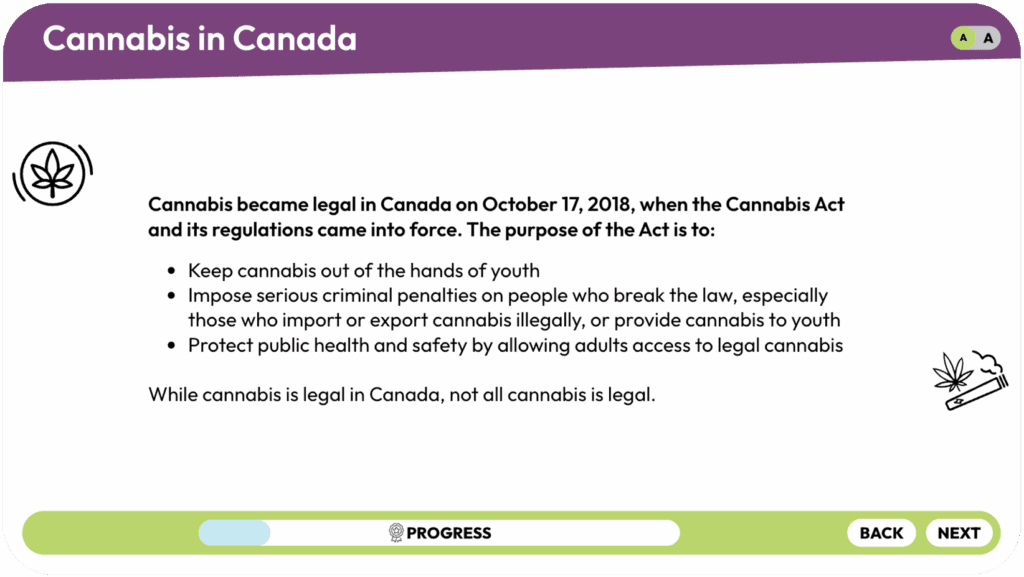
Teacher's Notes
The Cannabis Act creates a strict legal framework for controlling the production, distribution, sale and possession of cannabis across Canada.
The goal of legalization is to:
- Keep cannabis out of the hands of youth
- Impose serious criminal penalties on people who break the law, especially those who import or export cannabis illegally, or provide cannabis to youth
- Protect public health and safety by allowing adults access to legal cannabis
Cannabis is only legal in Canada for those of legal age, which varies depending on which province or territory you’re in. It’s important to know that not all cannabis is legal, and it can be difficult to know the difference.
Legal cannabis can only be bought from authorized retailers and is marked with identifying elements. This means there are still illegal products that some people may use.

Teacher's Notes
There are some key ways we can tell the difference between legal and illegal products. The easiest way is the packaging.
As you can see from this slide, legal cannabis packaging is plain, does not appeal to youth, has a standardized cannabis symbol and a health warning message.
Illegal cannabis products, like the one shown here, often come in colourful packaging and can sometimes have similar names to a candy or treat we are all familiar with.
Sometimes these products are even designed to look like well-known brands.
Just know that a legal product will never look like a snack you can buy at the grocery store.
It is important to be able to tell the difference between legal and illegal cannabis products because illegal cannabis products come with extra risks.
We will talk more about this on the next slide.
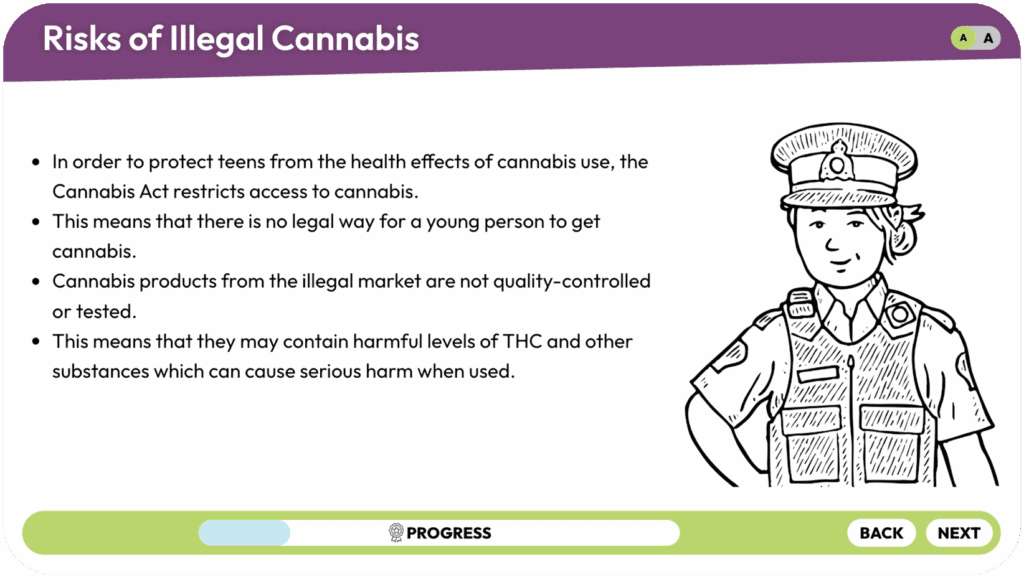
Teacher's Notes
In order to protect youth like you from the risks of cannabis use that were just mentioned, the Cannabis Act, restricts youth access to it. This means that there is no legal way for a young person to get cannabis.
This law is also in place to protect those of legal age from the risks of illegal cannabis. Legal cannabis can only be purchased through stores that have approval from the government. For example, something that is sold by a person instead of a store is illegal. This type of cannabis can be dangerous as it is not quality-controlled or tested. This means that these products may have harmful levels of THC, heavy metals, pesticides and other substances which can cause serious harm when used.
For example, in the US in 2019, an unregulated cutting agent was used in illegal THC-containing vaping products. This was associated with an outbreak of Vaping-Associated Lung Illness that sickened thousands and led to dozens of deaths.
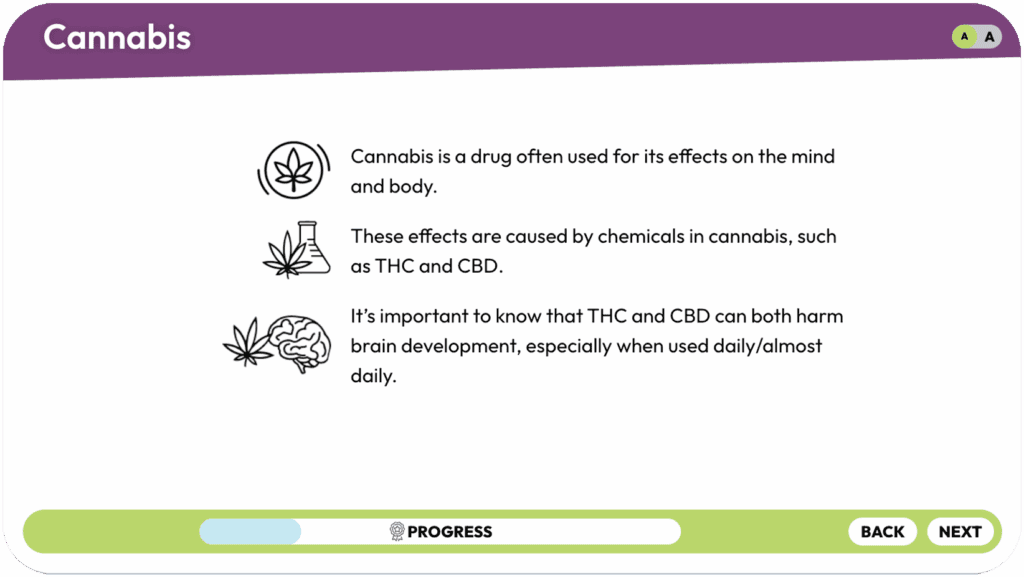
Teacher's Notes
Cannabis
Given the high-use rates of cannabis in Canada, it’s likely that many of you have been exposed to it in social settings. Cannabis is a drug often used for its effects on the mind and body.
There are hundreds of chemicals found in cannabis. Over 100 of these are known as cannabinoids. These cannabinoids interact with cannabinoid receptors located across the brain and body, which cause the stereotypical effects of cannabis.
Delta-9-tetra-hydro-cannabinol, also known as THC, is the most researched cannabinoid and causes the feeling of being ‘high,’ along with a range of other effects including impaired memory, anxiety, hunger, paranoia, red eyes, dry mouth, and an increased heart rate. The greater the THC level, the greater the risk of experiencing these effects.
Cannabidiol, also known as CBD, is unlike THC in that it doesn’t produce a high. Less is known about CBD compared to THC, but there is evidence to suggest that CBD can help manage some medical conditions including, as an example, seizures in children (aka epilepsy). Though the effects of CBD are mostly unnoticeable, it can still carry risks.
It’s important to know that THC and CBD can both harm brain development, especially when used daily or almost daily.

Teacher's Notes
Do any of you know what percent of THC content in dried or vaped cannabis is considered high risk?
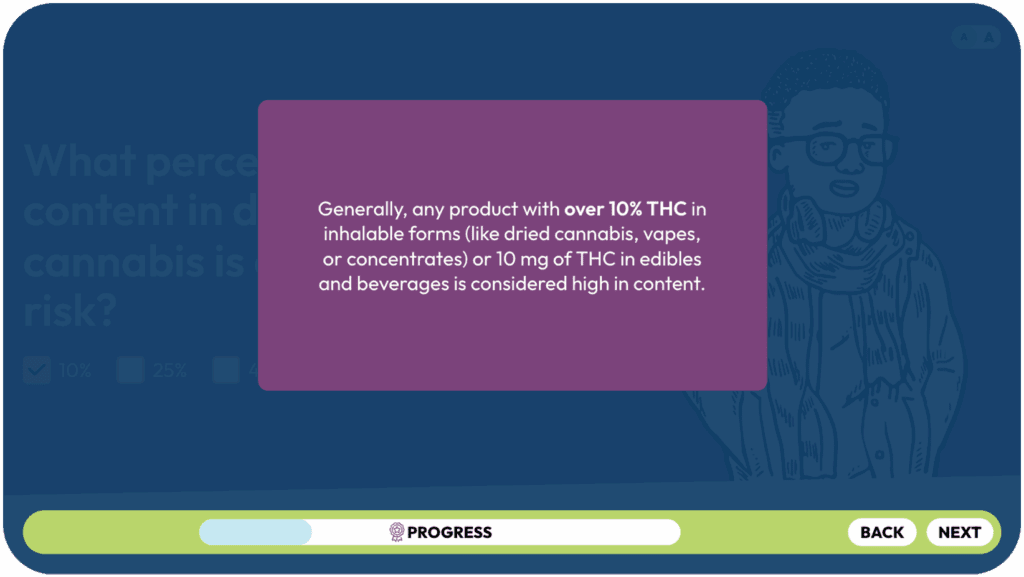
Teacher's Notes
After the class votes:
Generally, any product with over 10% THC in inhalable forms (like dried cannabis, vapes, or concentrates) or 10 mg of THC in edibles and beverages is considered high in content.
This means it carries higher risks, especially for teenagers and young adults because of its impact on brain development.
Cannabis concentrates that are vaped can be powerful and contain up to 90 % THC. The higher the THC content consumed, the greater the risks, particularly to mental health.

Teacher's Notes
Cannabis can be used in different ways such as:
- Smoking, often with a joint or bong
- Vaping, with a device like a vape pen
- Eating and drinking (think cannabis infused foods and drinks)
Let’s dive deeper into these and explore how each way carries its own risks.
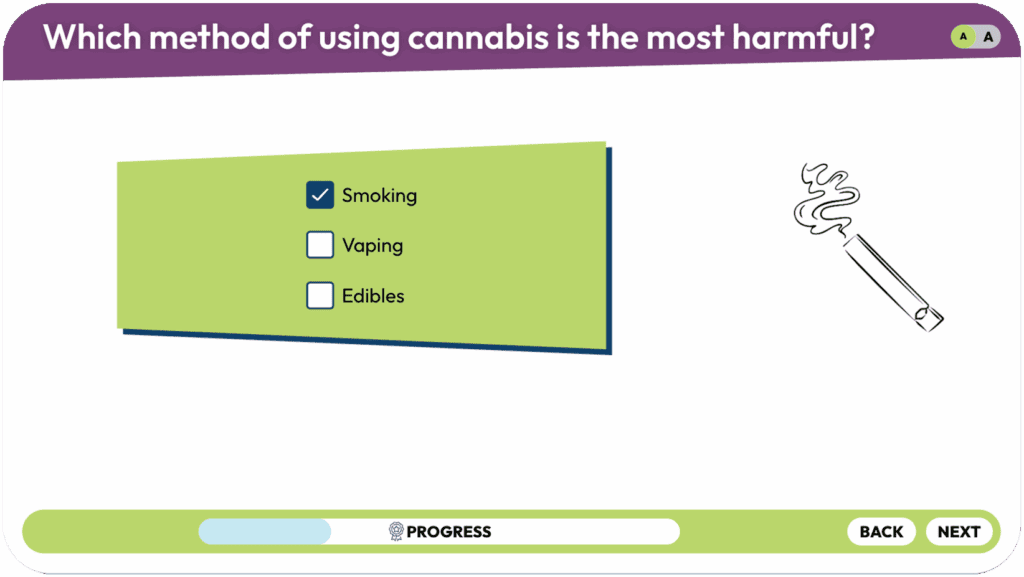
Teacher's Notes
Before we dive deeper and explore how each way carries its own risks, by show of hands, which do you think is the most harmful?
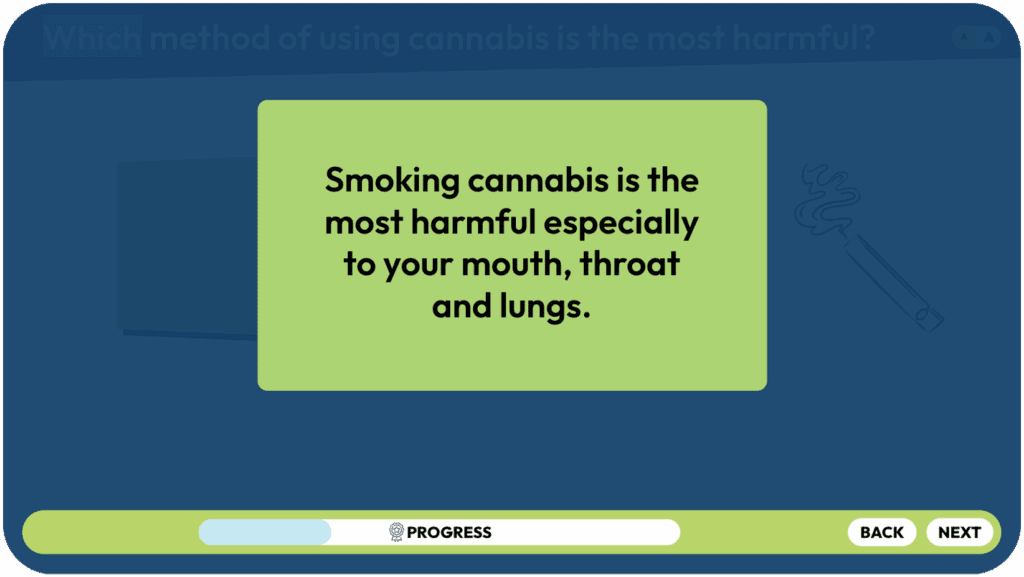
Teacher's Notes
After the class votes:
Smoking cannabis is the most harmful especially to your mouth, throat and lungs because it has some of the same harmful chemicals as the smoke from tobacco but each way to use cannabis has its own risks!
While vaping is thought to be less risky to your mouth, throat and lungs compared to smoking, it’s not risk-free.
And because smoked and vaped cannabis products contain the highest amounts of THC, they can pose the highest risks to mental health.
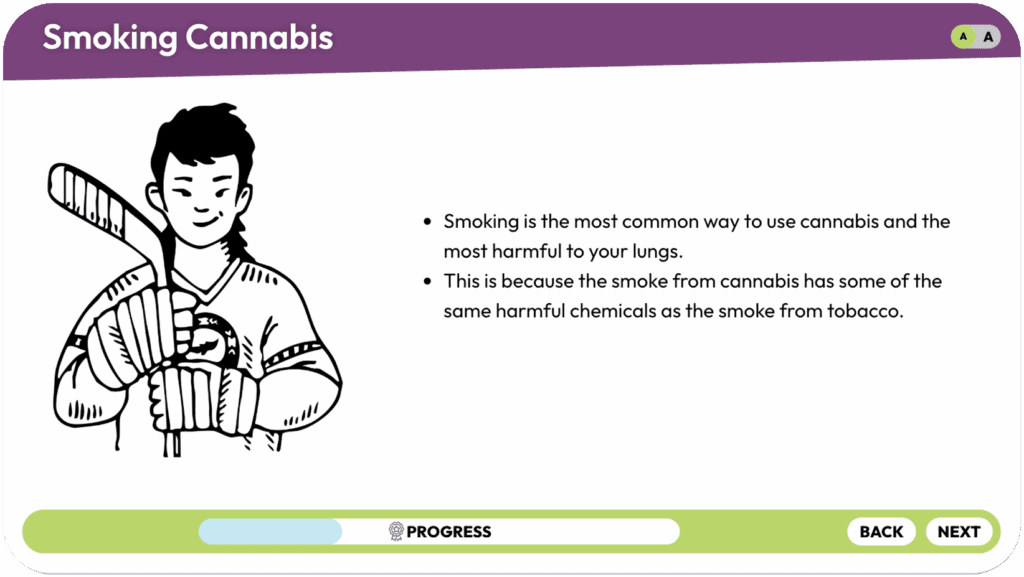
Teacher's Notes
Smoking is the most common way to use cannabis and the most harmful. In fact, research studies have found that cannabis smoking has been associated with increased risks of:
- Bronchitis
- Lung infections
- Chronic (long-term) cough
- Increased mucus buildup in the chest
Next, we will jump into vaping.
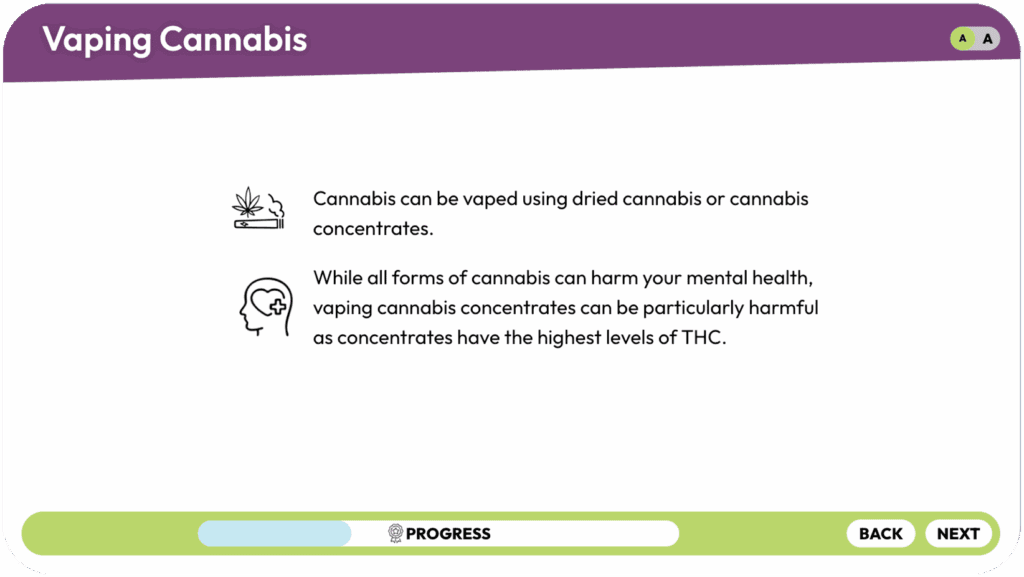
Teacher's Notes
Cannabis can be vaped using either dried cannabis or cannabis concentrates with a vaping device like a vape pen.
We often hear from youth and young adults that vaping is harmless. While vaping cannabis may be less harmful than smoking for your lungs, there are still risks, and the long-term effects are unknown. Cannabis concentrates for vaping are particularly risky to your mental health due to the high THC levels.
Since it’s a newer way to use cannabis, scientists know less about the effects, harms and risks of vaping compared to smoking cannabis. However, rates of vaping cannabis have significantly increased in recent years, particularly related to vaping cannabis ‘concentrates’.
This is the strongest kind of cannabis, and because it’s strong, it can also be the most harmful to the brain.
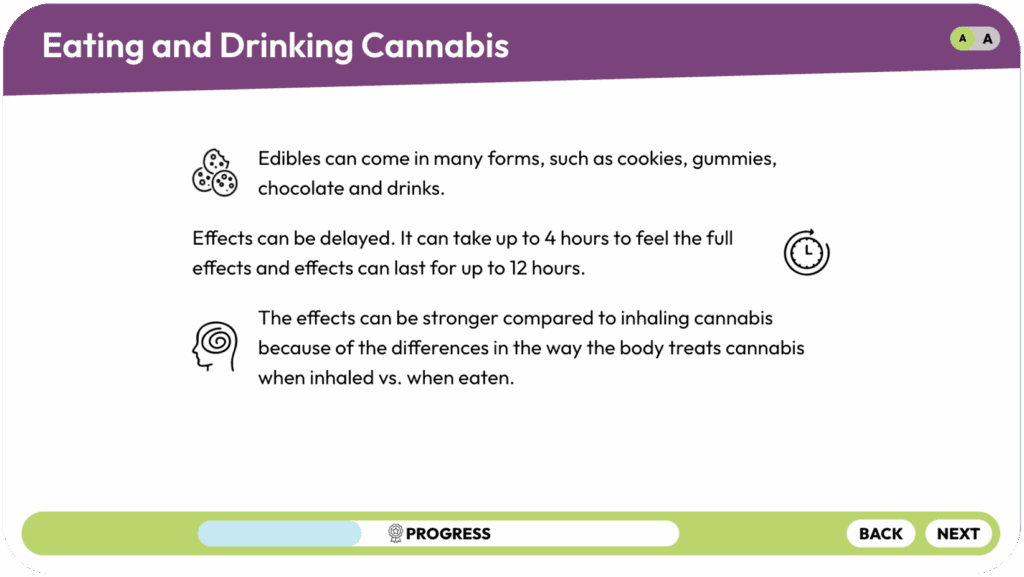
Teacher's Notes
Edible cannabis can come in many forms, such as drinks, baked goods or candies.
It’s important to know that the effects can be delayed. It can take up to 4 hours to feel the full effects of edibles with some lingering effects lasting up to 12 hours. This is because of the differences in the way the body treats THC when eaten vs. inhaled.
When eaten, THC breaks down in the liver first and is made into a stronger form of THC before reaching the brain. Eating or drinking more cannabis before the 4-hour mark can lead to very strong mental and physical effects, including vomiting and severe paranoia or anxiety, that may need urgent medical attention.
Edibles can also be risky because some people accidentally eat or drink them without knowing there is cannabis in them. Since legalization, hospitals have seen an increase in visits to the emergency room and poison centres have seen an increase in calls because of accidental cannabis poisonings in children.
It’s important for anybody who uses edible cannabis products to keep them in a high place and locked and away from other food items to avoid confusion.

Teacher's Notes
Chapter Two: Effects & Risks
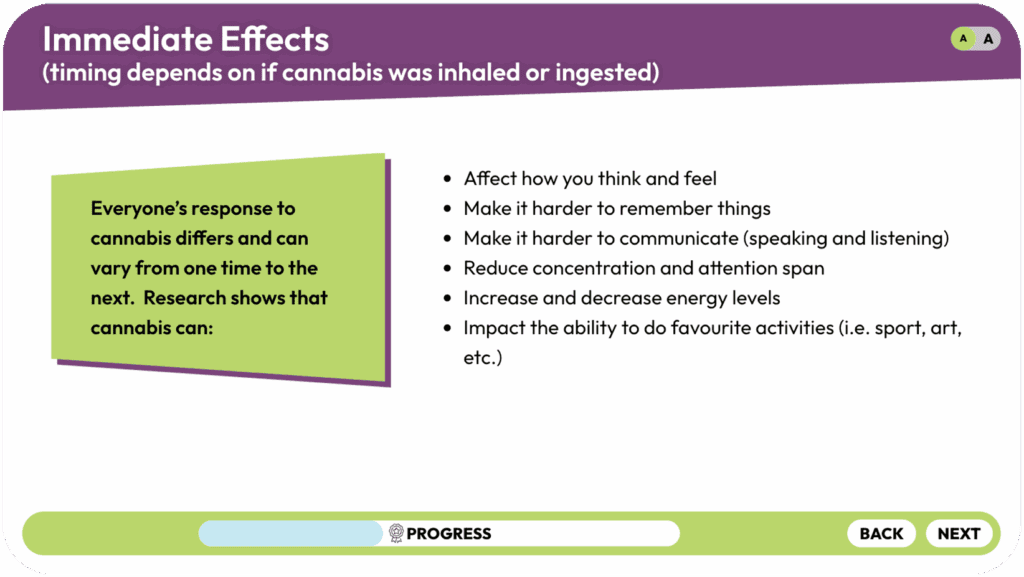
Teacher's Notes
There are a range of effects cannabis can have on a person and everyone’s response to cannabis differs, varying from one time to the next.
While many of you may know cannabis for its positive effects (like feeling happy, excited or relaxed), there are also negative effects that must be considered.
For example, cannabis:
- Affects mood and feelings, making you feel a potential range of emotions, including happiness, sadness, excitement, anxiety or panic. In rare cases, cannabis can trigger a psychotic episode (not knowing what’s real, experiencing paranoia, having disorganized thoughts and in some cases, hallucinating) which can require medical attention.
- Reduces concentration and attention, impairs coordination and slows reaction time.
- Can make it more challenging to learn and remember things. As a result, you may have problems paying attention, remembering, learning things and making decisions after using cannabis.
- May impact your ability to perform at your best while participating in sports and other activities.
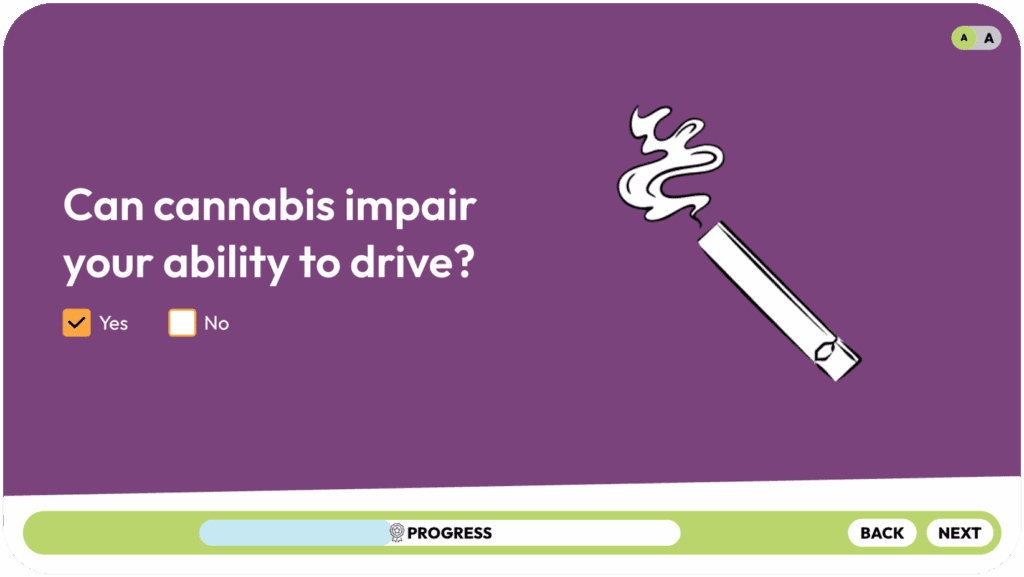
Teacher's Notes
With the immediate effects in mind, do you think cannabis impairs your ability to drive? In other words, is it safe to get behind the wheel after using the substance?

Teacher's Notes
After the class votes:
The answer is yes. Cannabis impacts your ability to drive.

Teacher's Notes
We’re going to watch a quick video about how cannabis impacts your ability to drive.
Play video.
Some people think it’s ok to drive after using cannabis because it helps them focus or makes them a “better driver”, or they think they can’t get caught.
We just learned about the broad range of effects that can be experienced after using cannabis. Because of these effects, it’s irresponsible and unsafe to drive after cannabis use. That’s why it’s against the law.
Science has shown that cannabis can impair a person’s ability to drive because it reduces the ability to react quickly, interferes with attention and impairs coordination. These skills are essential for driving safely and police have greater tools now than ever to detect cannabis impaired driving.
If you know someone who has used cannabis and plans to drive, don’t get in a car with them. Instead, please consider a safer way to get yourself home. Call an Uber, Lyft or taxi or ask someone you trust to come and pick you up.

Teacher's Notes
Whether you’re using cannabis to have fun with friends, relax or cope with poor mental health, it’s important to understand the long-term risks.
Scientific studies consistently show that daily or near daily cannabis use over time can increase your risks.
The first risk we’ll go over is the potential for developing and worsening symptoms of anxiety and depression.
Though cannabis is used by many to provide temporary relief from daily stressors, or from feeling anxious or down, long-term cannabis use hasn’t been found to improve mental health over time. Rather it contributes to consistent mental health struggles, even during times when you’re not using cannabis.
Frequent use also impairs your dopamine system.
Evidence tells us that daily cannabis use can impair the brain’s dopamine system, which is responsible for feelings of joy, excitement, and pleasure. Lower dopamine levels can negatively impact your mood, energy and excitement for things.
We also know that daily or near daily use can lead to cannabis dependency.
Like other drugs and alcohol, a person can develop a dependency on cannabis. In severe cases, this can progress to a cannabis use disorder. Cannabis dependence can include thinking a lot about the substance, feeling like you need to use it, craving it, increasing your tolerance to it, finding it hard to stop or reduce use and feeling increasingly restless, moody and/or anxious when not using it. Being dependent on cannabis can contribute further to anxiety and depression.
In rare but severe cases, it can lead to psychosis and schizophrenia. Psychosis is temporary and can involve severe paranoia and hearing or seeing things that aren’t real (e.g., hallucinations).
Schizophrenia, on the other hand, is a chronic mental health condition that requires life-long treatment. It is characterized by paranoia, hallucinations and disordered thinking. Adolescents and young adults, particularly males, as well as those struggling with cannabis dependence, are at greatest risk of psychosis or schizophrenia.
These effects can be frustrating, distressing or frightening. If you’re using cannabis daily or near daily and feel that you’re having difficulty remembering, focusing and controlling your thoughts, studies suggest that reducing or stopping your use can help reduce those feelings over time. However, stopping or reducing use may not be easy, especially for those who have used cannabis for a long time.
For help stopping or reducing your cannabis use, try talking to someone you trust like a healthcare professional, counsellor, friend or family member.
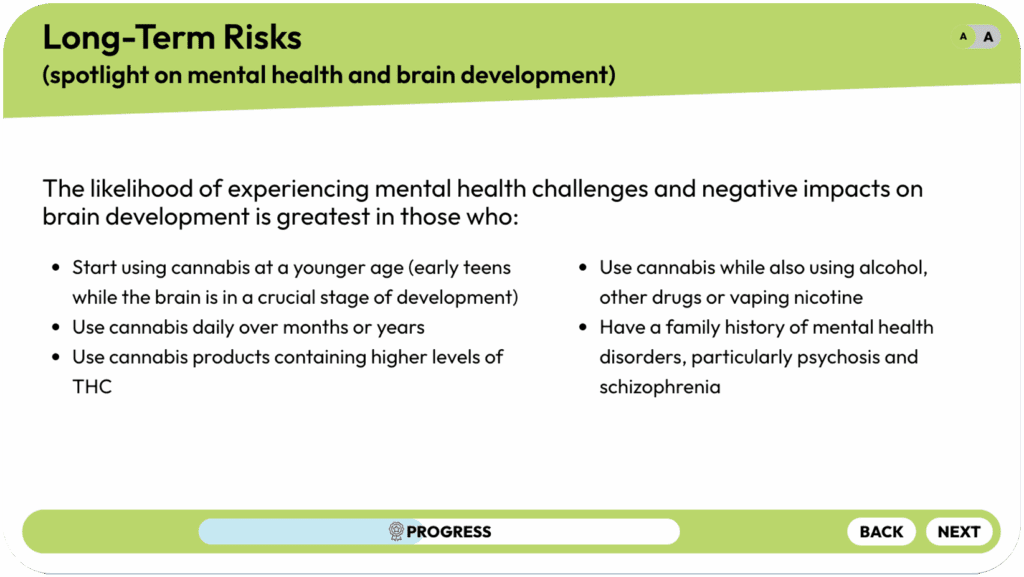
Teacher's Notes
As mentioned, if you’ve used cannabis in the past a couple of times, don’t be alarmed.
The likelihood of experiencing mental health challenges and negative effects on brain development is greatest in those who:
- Started using cannabis earlier in age.
- Use cannabis daily or near daily and over a long period of time, for weeks or months.
- Use higher strength products such as dried cannabis, vape pens with cannabis concentrates or other types of cannabis concentrates such as shatter, wax, budder or others.
- Have a family history of mental health disorders, such as psychosis or schizophrenia.
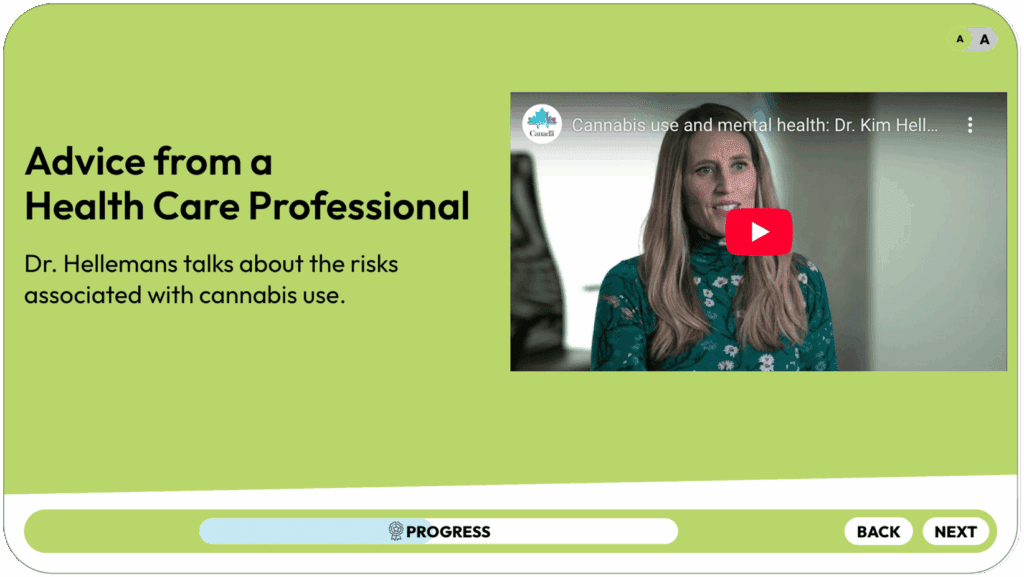
Teacher's Notes
A medical professional talks about the risks associated with cannabis use.
When ready, press the play button to start a short video.

Teacher's Notes
Let’s test your knowledge with some questions! Which products are illegal?

Teacher's Notes
After the class votes:
Items B and C are illegal.
A and D are legal. You can tell because of the standardized label.

Teacher's Notes
Next question, does cannabis improve your memory?

Teacher's Notes
After the class votes:
No. In fact, cannabis can negatively impact your memory.
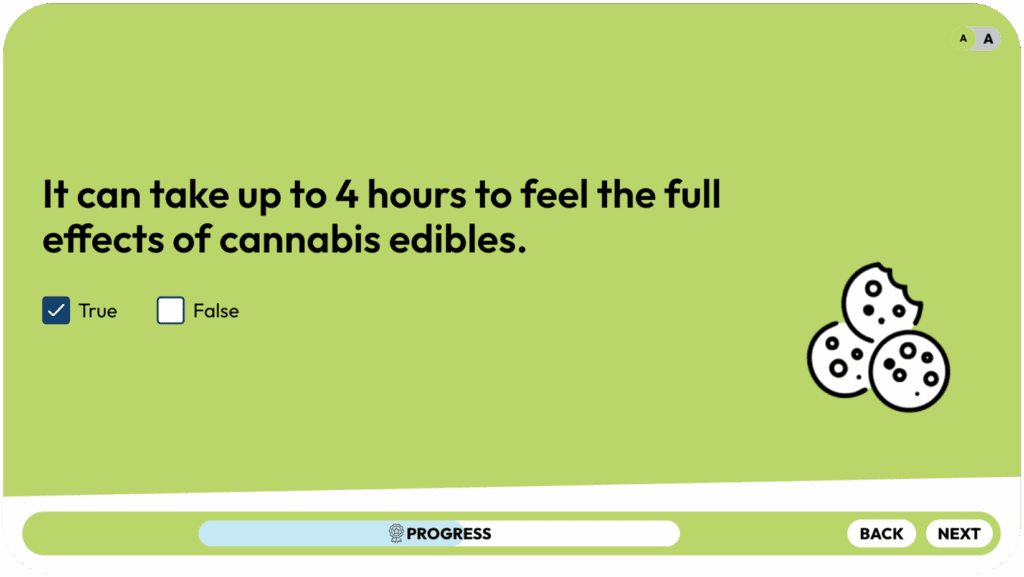
Teacher's Notes
Alright, two more questions. True or False: It can take up to 4 hours to feel the full effects of cannabis edibles.
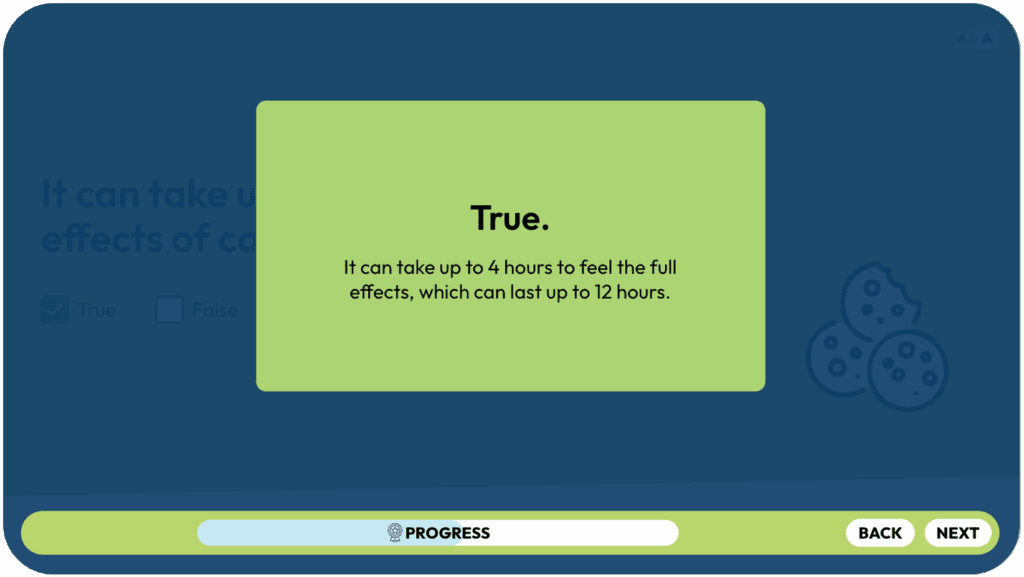
Teacher's Notes
After the class votes:
True.
It can take up to 4 hours to feel the full effects, which can last up to 12 hours.

Teacher's Notes
Alright, last trivia question. Vaping cannabis poses no risks to lung health, unlike smoking: True or False?

Teacher's Notes
After the class votes:
False. While vaping poses a marginally lower risk than smoking cannabis, there are still risks. Plus, the full extent of the long-term effects are still unknown due to the fact this is a newer method of consuming cannabis.

Teacher's Notes
It’s also important to know that mixing cannabis with other substances, like when smoking tobacco or drinking alcohol, greatly increases the level of risk.
For example, using cannabis and alcohol at the same time can provide a range of intense immediate effects. These include feelings of excitement, confusion and dizziness. It can also cause nausea, vomiting, paranoia and anxiety.
Combining these two substances can reduce your brain performance (affecting your memory and ability to concentrate, talk and make decisions) and increase your chances of engaging in risky or harmful behaviour (like driving under the influence).
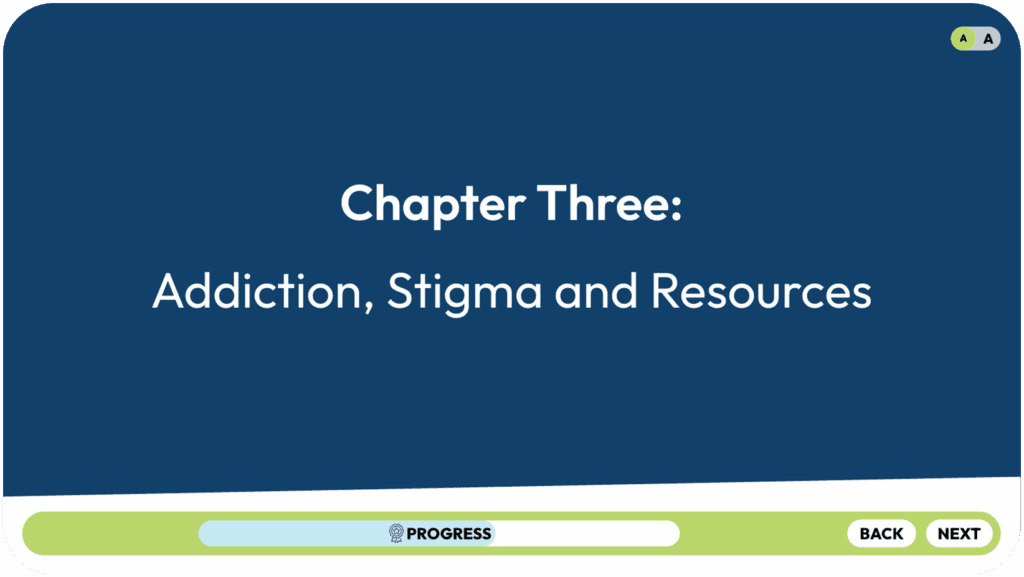
Teacher's Notes
Chapter Three: Addiction, Stigma & Resources

Teacher's Notes
Now we’re going to talk about Addiction and Stigma related to cannabis use.
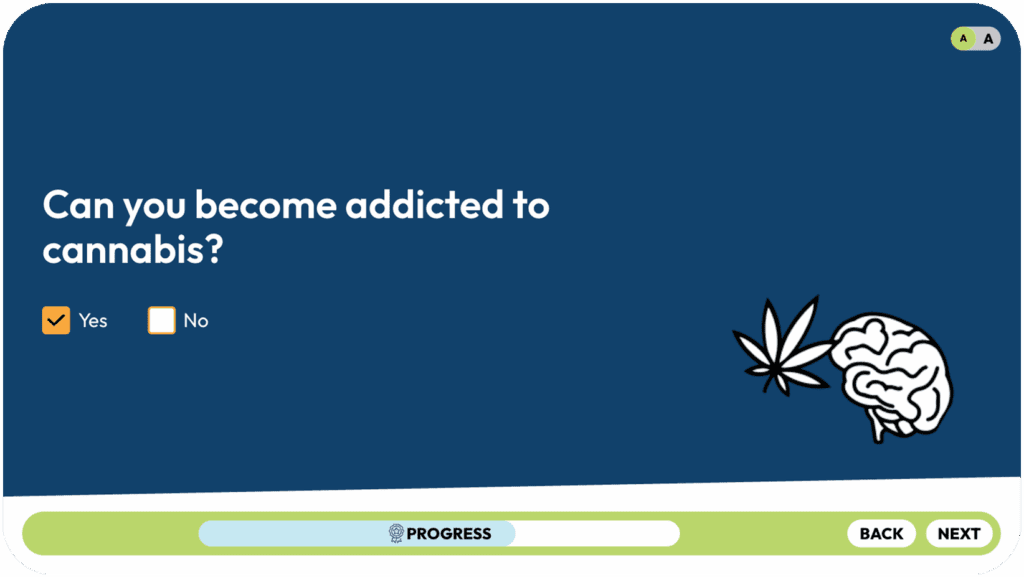
Teacher's Notes
Just before we get to that, we have a quick quiz: Can you become addicted to cannabis? Yes or No?

Teacher's Notes
After the class votes:
Yes. In fact, addiction can develop at any age, but youth are especially vulnerable because the brain is still developing.
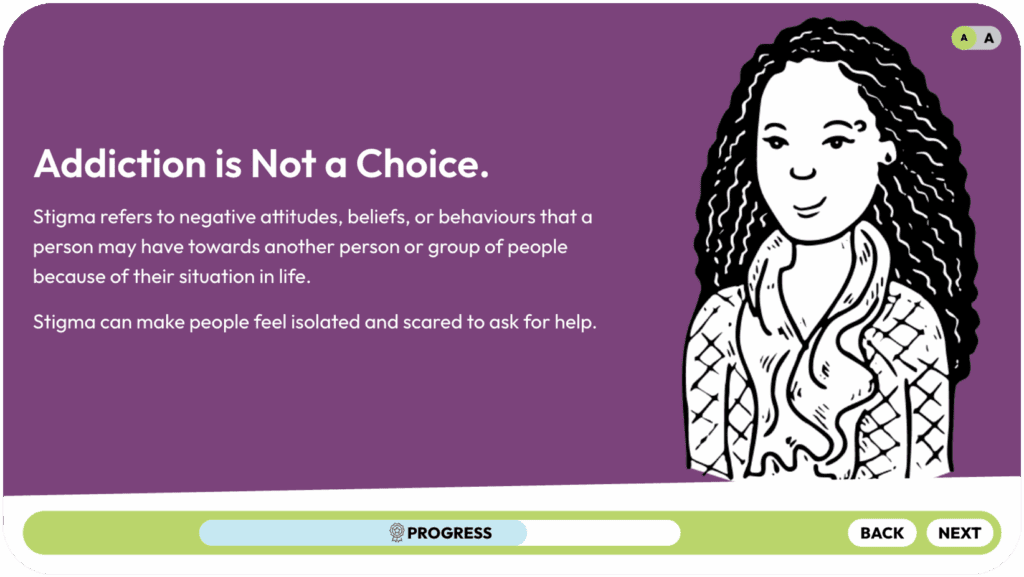
Teacher's Notes
Addiction is when someone has a strong desire to do something again and again in a way that’s hard to control or stop.
Addiction is actually considered a disorder since it changes your brain, making you crave and keep taking a substance or repeat a behaviour even when you want to stop.
When talking about cannabis, a person might continue to use it even though it’s causing problems for them or others, like their family or friends.
Some people struggling with addiction can find it hard to take care of themselves or others, since their brain is so focused on the need to keep taking the substance. It’s important to remember that addiction isn’t a choice; it’s a treatable medical condition and it’s possible to get better.
Unfortunately, there’s a lot of stigma around addiction. Stigma refers to negative attitudes, beliefs or behaviours that we may have towards another person or group of people because of their situation in life.
Sometimes people’s attitudes and behaviours can create stigma because they may be influenced by stereotypes, negative stories and images about people who use drugs. The stigma around addiction is especially harmful because it can make a person who is struggling with addiction feel isolated and makes it harder for them to ask for help. That’s why it’s important always to treat everyone with kindness, respect and compassion regardless of their situation.
If you or someone you know is struggling with an addiction to cannabis or other drugs, get help: reducing or stopping cannabis use can be difficult to do on your own. Try getting support from a healthcare professional, counsellor, trusted friend or family member.
Help is also available through a number of online resources, including the Kids Help Phone which is available to anyone under 20 years old. The contact information for this service will be at the end of the presentation.

Teacher's Notes
Hannah shares her story about cannabis use.
When ready, press the play button to start a short video.

Teacher's Notes
So far, we’ve discussed how cannabis can harm your mental health and the way your brain functions.
As mentioned already, some people may use cannabis to help with feelings of anxiety and depression, even though scientific evidence shows that cannabis DOES NOT improve long-term mental health.
Instead of using cannabis to cope, there are many science-backed strategies to improve short and long term mental health. Let’s discuss a few of these ways.

Teacher's Notes
First, you can engage in mindful deep breathing – your brain and body need oxygen to feel calm, focused, and confident. Spending a few minutes a day just focusing on your breathing can make you more aware of your thoughts and emotions and slow down your racing mind.
Next, be sure to stay hydrated – what happens when you give water to a plant that’s looking limp? It perks right up. So does your brain and body when you have enough H20. This helps maximize your mental health and elevate your mood.
Don’t forget to get enough sleep – how can you feel motivated, happy, excited or up for stuff if you aren’t getting the sleep you need? Aim for 8 to 10 hours per night.
Consider limiting social media – try your best to limit the time you spend on TikTok, Instagram and other social media platforms. Scientists have discovered that the more time spent on social media, the more your mental health and brain performance suffers.
And finally, participate in regular physical activity – doing so can help lower feelings of anxiety and depression and can even help prevent mental health disorders from ever developing. This could include going outside for a walk, following a regular exercise routine, playing a team sport or going for a jog.
Please note: If physical activity is a challenge in your life, you could also try listening to music, cooking or baking or creating art, all of which trigger the release of the ‘feel-good’ chemical dopamine and decreases the stress-causing hormone cortisol.
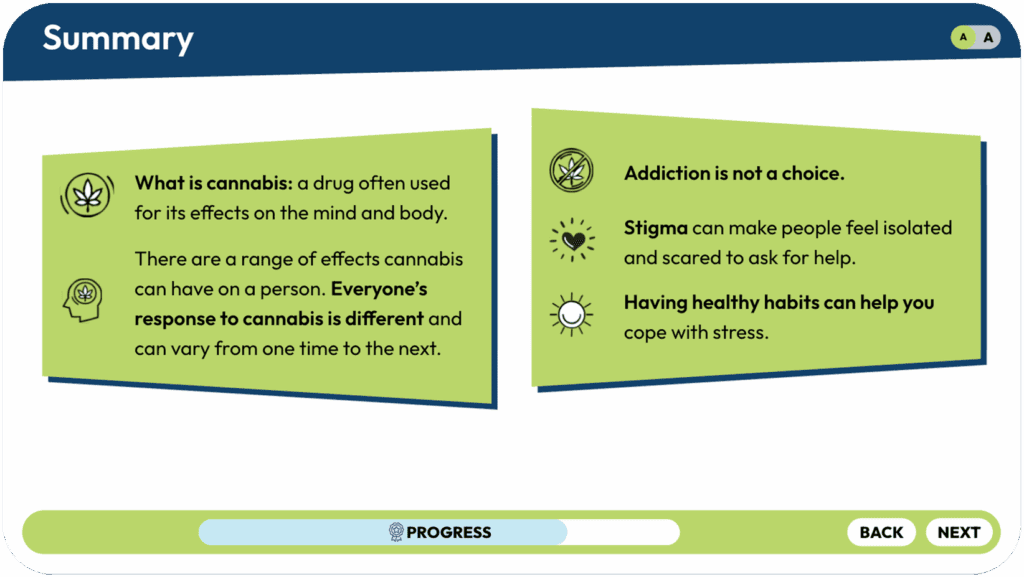
Teacher's Notes
In summary, here are a few key things we’ve talked about today:
Cannabis is a drug often used for its effects on the mind and body. These effects are caused by chemicals in cannabis, such as THC and CBD. It’s important to know that both THC and CBD can harm brain development, especially when used daily or almost daily.
We’ve learned that there are a range of effects cannabis can have on a person. Everyone’s response to cannabis is different and can vary from one time to the next.
Whether you’re using cannabis to have fun with friends, relax or cope with poor mental health, it’s important to understand the long-term risks.
We know that addiction is not a choice and that stigma can make people feel isolated and scared to ask for help.
Having healthy habits can help you cope with stress. Think about how you can incorporate healthy habits into your daily routine, such as mindful deep breathing, hydration, sleep, limiting social media consumption and by participating in physical activity.

Teacher's Notes
It’s trivia time again.
True or False: Starting to use cannabis at a younger age can increase the likelihood of mental health challenges.
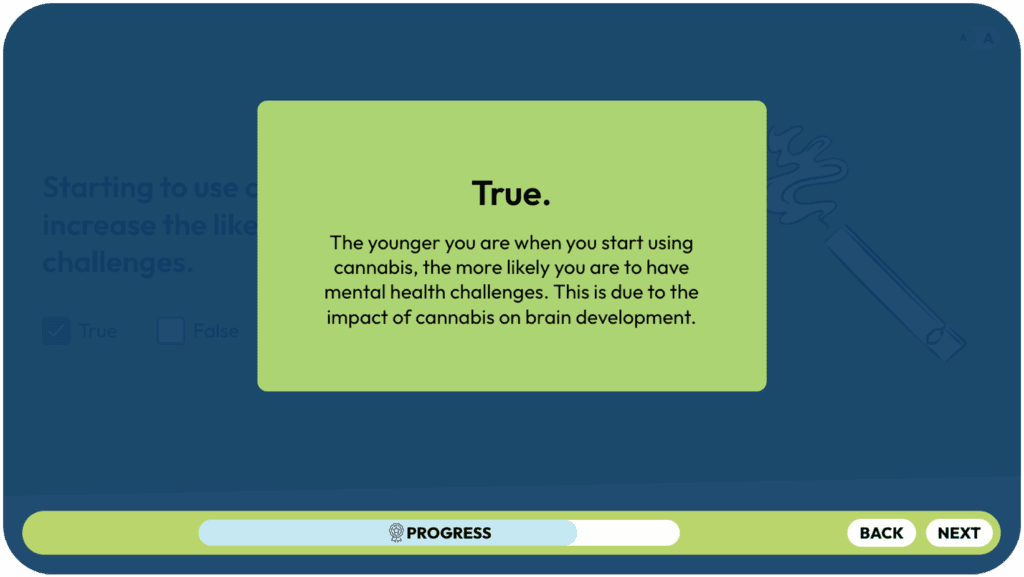
Teacher's Notes
After the class votes:
True. The younger you are when you start using cannabis, the more likely you are to have mental health challenges. This is due to the impact of cannabis on brain development.

Teacher's Notes
Question number two:
True or False: Cannabis is a performance enhancing drug.
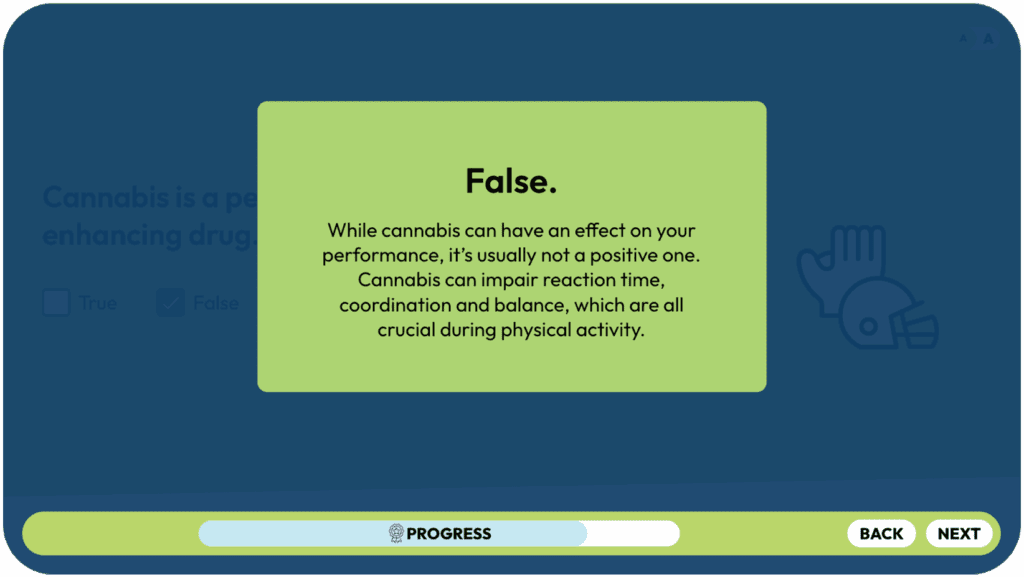
Teacher's Notes
After the class votes:
False.
While cannabis can have an effect on your performance, it’s usually not a positive one. Cannabis can impair reaction time, coordination and balance, which are all crucial during physical activity.
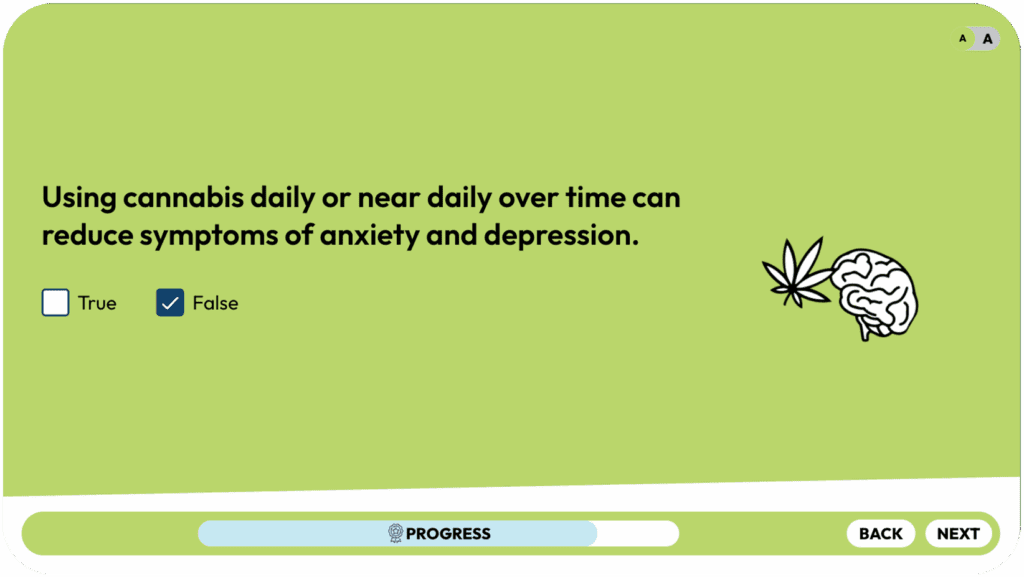
Teacher's Notes
Trivia question three:
True or False: Using cannabis daily or near daily over time can reduce symptoms of anxiety and depression.
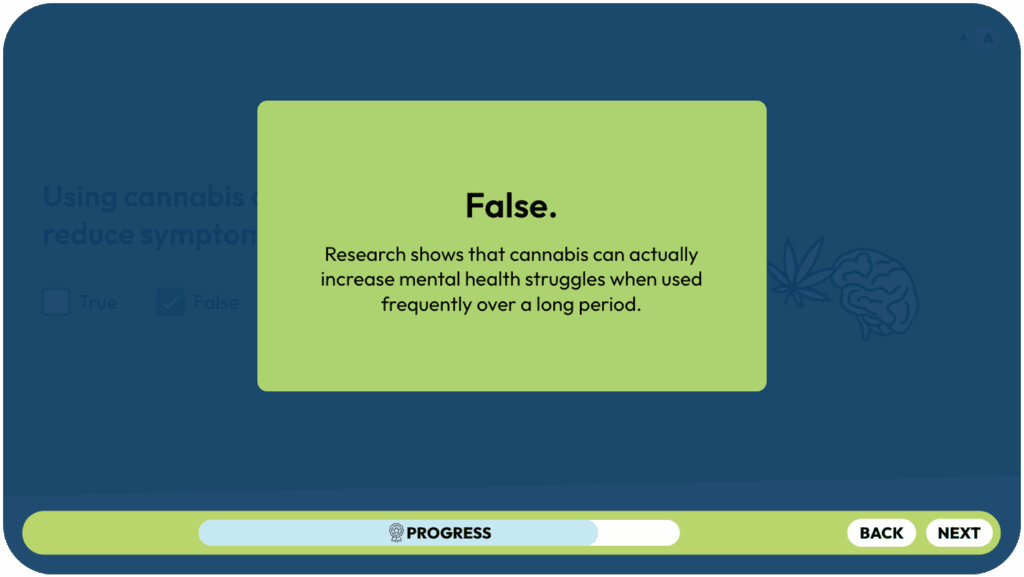
Teacher's Notes
After the class votes:
False.
Research shows that cannabis can actually increase mental health struggles when used frequently over a long period.

Teacher's Notes
Number four:
True or False: Combining substances can reduce your brain performance and increase your chances of engaging in risky or harmful behaviour.

Teacher's Notes
After the class votes:
True. These are two of many unwanted effects of combining cannabis with other substances.

Teacher's Notes
Finally, after today what can you do to increase your cannabis awareness?
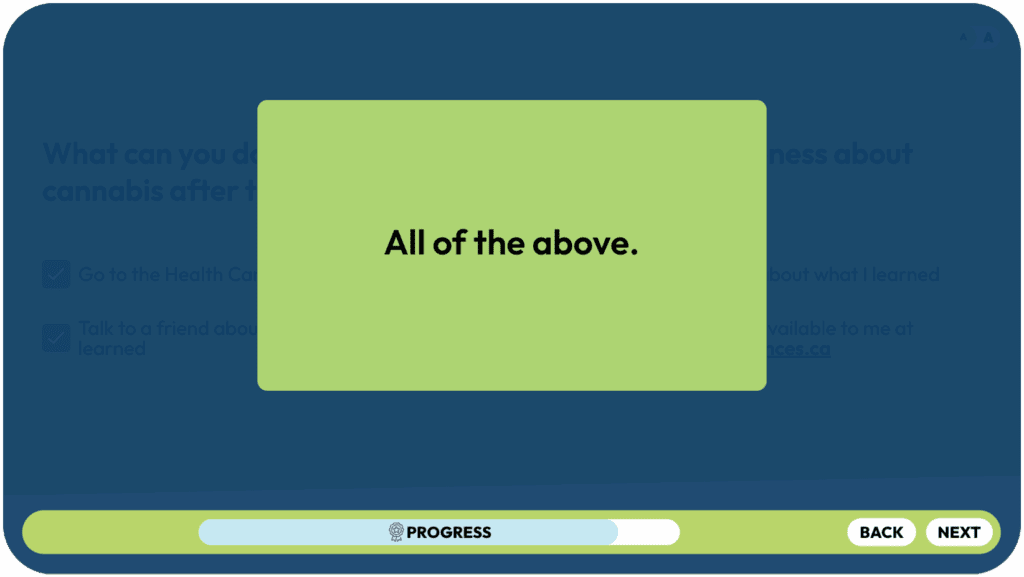
Teacher's Notes
After the class votes:
These are all great options for you to increase your awareness.

Teacher's Notes
Thank you for your time and attention today. Does anyone have any questions?
If you’re not comfortable asking in front of the class, you can come speak to me later as well.
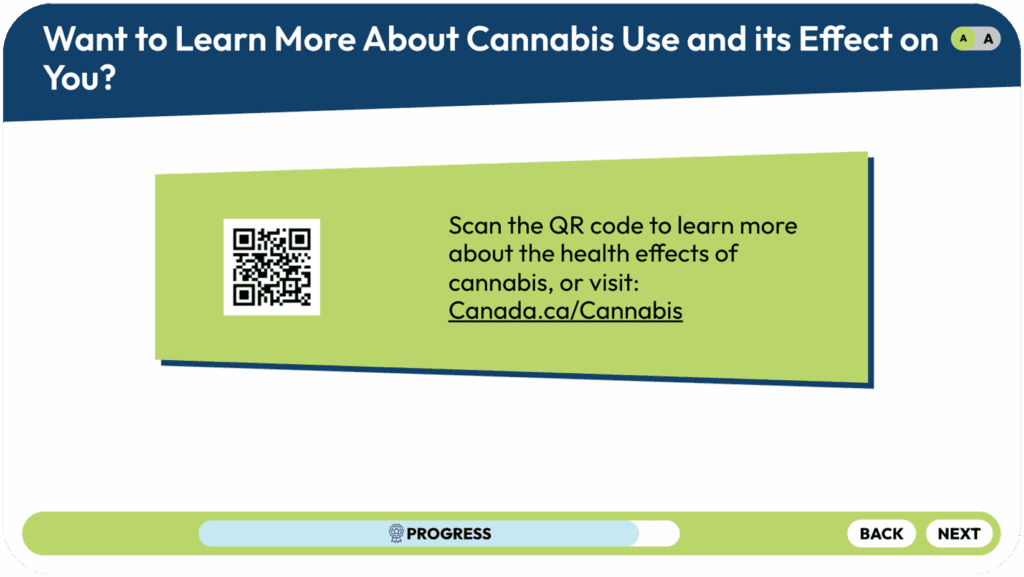
Teacher's Notes
Want to learn more about cannabis use and its effects? Scan the QR code to learn more about the health effects of cannabis, or visit: Canada.ca/Cannabis.

Teacher's Notes
Here are a few more resources you may find useful after today.
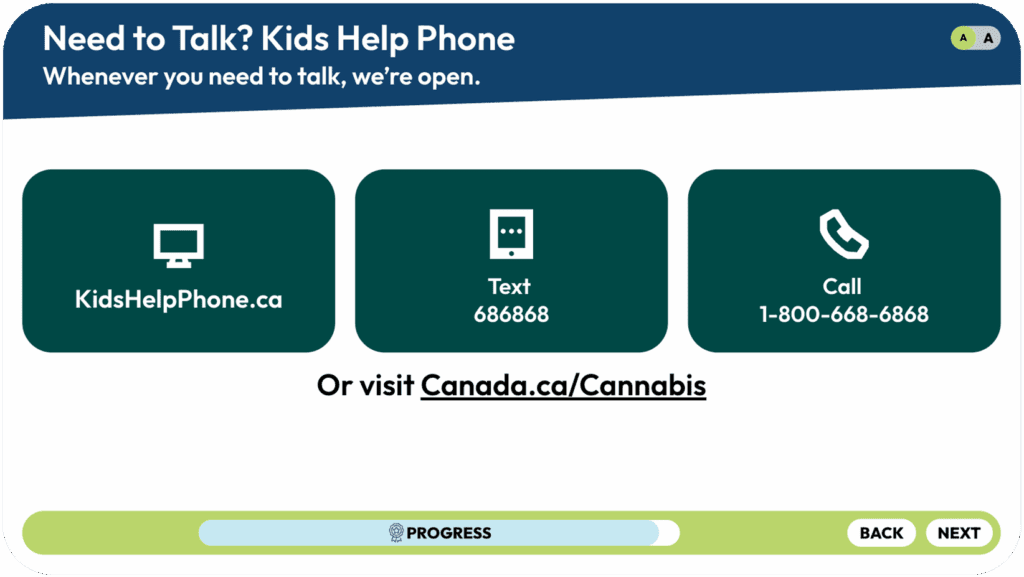
Teacher's Notes
Talking about substances and mental health can bring up strong feelings.
If you or someone you know is struggling with, or has questions about, substance use and/or mental health, the Kids Help Phone is there.
This service offers 24/7 bilingual and confidential support by phone and text, as well as live, virtual chat in the evenings for anyone up to 20 years old.

Teacher's Notes
Thank you for participating in Health Canada’s All About Cannabis teacher-led module.
This presentation and additional resources can be found at HealthCanadaExperiences.ca
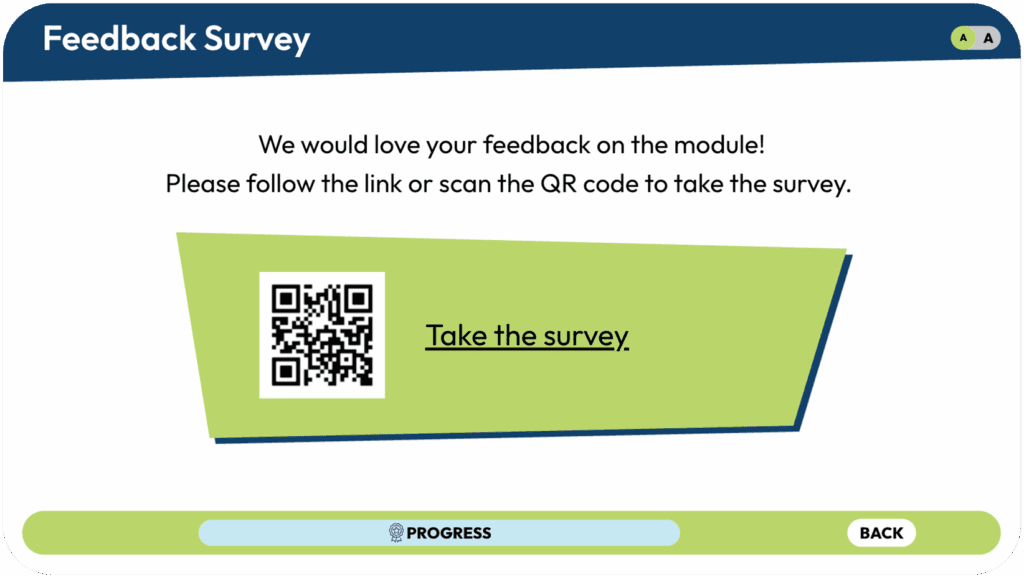
Teacher's Notes
We would love your feedback on the module!
A short survey has been provided at the end of the presentation to gather student feedback. Please encourage your students to complete.
Health Canada also offers other programs on substance use, including:
Find out more at HealthCanadaExperiences.ca.

